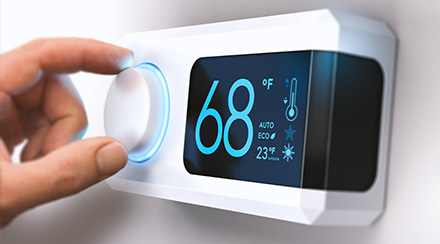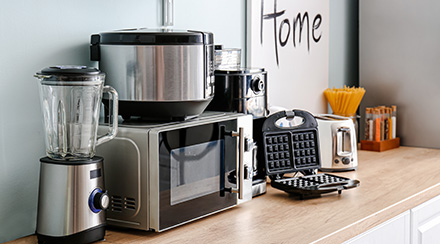What Is ENERGY STAR?

If you’ve been shopping for appliances or electronics in the past few decades, you might be familiar with the blue and white ENERGY STAR logo. But do you know what it means? Keeping an eye out for it may help you save on energy costs, and if you really want to do a deep dive into the most energy-efficient appliances and electronics, ENERGY STAR could be your most helpful resource.
What is ENERGY STAR?
ENERGY STAR is a federal program operated in cooperation between the U.S. Environmental Protection Agency (EPA) and the U.S. Department of Energy. It was established in 1992 to provide objective, standardized information about the energy consumption of consumer products and to promote energy efficiency.
Manufacturers of appliances and electronics submit their product testing data to ENERGY STAR for certification, and the models that meet the highest energy efficiency standards can be sold with the ENERGY STAR logo. ENERGY STAR also certifies newly constructed homes, commercial buildings and industrial facilities that meet high efficiency standards.
How Does a Product Become ENERGY STAR Certified?
ENERGY STAR offers certifications of more than 75 different types of products, including kitchen appliances, washers, dryers, computers, televisions and HVAC equipment. The specific standards that qualify a product for ENERGY STAR certification differ by category.
For example, ENERGY STAR-certified refrigerators must include compressors, insulation and defrosters that each meet strict energy efficiency guidelines, resulting in refrigerators that are at least 9 percent more efficient than the average new model. And ENERGY STAR-certified light bulbs use at least 90 percent less energy than standard bulbs, last at least 15 times longer and produce about 70 to 90 percent less heat.
ENERGY STAR requires manufacturers to submit their products to EPA-approved laboratories for testing to ensure they meet energy efficiency targets without compromising product performance or quality. If satisfactory test results are certified by an EPA-approved certification body, the product can carry the ENERGY STAR logo – but ongoing off-the-shelf product testing helps ensure that all ENERGY STAR certified products are delivering their promised energy savings.
How Does a Home or Building Become ENERGY STAR Certified?

Because so much of our energy consumption is tied to homes and buildings, ENERGY STAR has developed programs to certify these structures and encourage more energy-efficient construction.
For residential homes, ENERGY STAR has created a partnership program to help homebuilders design and build ENERGY STAR certified homes from the ground up. Supported by guidance and resources from ENERGY STAR, these homebuilders select energy-efficient features and hire an energy rating company to assist with quality control throughout the building process. Once construction is complete, the energy rating company performs its final inspection and sends the results to a home certification organization for final approval. Certified homes receive an ENERGY STAR label, which is usually placed on the electrical circuit box.
ENERGY STAR-certified homes are built with comprehensive air sealing, energy-efficient windows and doors, high efficiency HVAC equipment, comprehensive water management systems and features that promote indoor air quality. They are at least 10 percent more efficient than homes that are built to code, but they average around 20 percent greater efficiency – and according to some studies, they sell for an average of six percent more than comparable homes that lack certification.
New commercial buildings can also be designed to be ENERGY STAR certified, or they can be modified to meet the program’s requirements. Building features are measured and evaluated to give the building a score on the 100-point ENERGY STAR scale. To qualify for ENERGY STAR certification, the building must score a 75 or higher. Once a building is certified, it must submit to an annual energy efficiency inspection and recertification to maintain its status.
How Can ENERGY STAR Help You Save Money?
Anything you can do to reduce your energy use at home can make a difference on your energy bill. You’ll get the most bang for your buck by choosing ENERGY STAR certified products for your most energy-hungry appliances like heating and cooling systems, water heaters, clothes dryers and refrigerators.
If you’re in the market for a specific type of appliance or device, you can use the ENERGY STAR Product Finder to search all of the available certified models. Results can be sorted by brand and product features, but they can also be ranked by efficiency to help you compare models and choose the most efficient product that meets your needs.
ENERGY STAR Rebates
You may be able to save even more by qualifying for ENERGY STAR rebates or other financial incentives. You can use the ENERGY STAR Rebate Finder to search for available offers by zip code. Government agencies at the federal, state and local levels sometimes use ENERGY STAR rebate programs to help reduce the demand for energy and reach energy efficiency goals.
If you’re looking for a new home, many online real estate websites allow you to filter results based on green features including ENERGY STAR certification. And if you’re thinking about building a new home, you can search online for local builders who are currently constructing ENERGY STAR certified homes.
Saving energy isn’t always straightforward, but the easy-to-spot blue and white ENERGY STAR logo makes it a little easier to find energy-efficient homes and products.
Looking for Something Specific?
Select a category to find resources for topics that interest you.
Select Category

Related Articles:

Tips for Improving Your AC and Furnace Efficiency
We share maintenance tips for your heater and AC, and home improvement tips to help you use those systems less.
Read Article
Tips for Saving on Energy in Your Home
If you’re looking to learn more about energy efficiency for home systems and appliances, we’re sharing our favorite energy-saving tips.
Read Article
What Uses the Most Electricity In a Home?
We break down what uses the most energy in your home to give you an understanding of where your energy usage goes and where energy-saving tactics can make the most impact.
Read ArticleMost Popular Articles

Energy Plans to Fit Your Lifestyle
NRG offers electricity and natural gas plans with perks like cash back, travel rewards and more, so you can find a plan that fits your home and family.
What Is ENERGY STAR?
If you’ve been shopping for appliances or electronics in the past few decades, you might be familiar with the blue and white ENERGY STAR logo. But do you know what it means? Keeping an eye out for it may help you save on energy costs, and if you really want to do a deep dive into the most energy-efficient appliances and electronics, ENERGY STAR could be your most helpful resource.
What is ENERGY STAR?
ENERGY STAR is a federal program operated in cooperation between the U.S. Environmental Protection Agency (EPA) and the U.S. Department of Energy. It was established in 1992 to provide objective, standardized information about the energy consumption of consumer products and to promote energy efficiency.
Manufacturers of appliances and electronics submit their product testing data to ENERGY STAR for certification, and the models that meet the highest energy efficiency standards can be sold with the ENERGY STAR logo. ENERGY STAR also certifies newly constructed homes, commercial buildings and industrial facilities that meet high efficiency standards.
How Does a Product Become ENERGY STAR Certified?
ENERGY STAR offers certifications of more than 75 different types of products, including kitchen appliances, washers, dryers, computers, televisions and HVAC equipment. The specific standards that qualify a product for ENERGY STAR certification differ by category.
For example, ENERGY STAR-certified refrigerators must include compressors, insulation and defrosters that each meet strict energy efficiency guidelines, resulting in refrigerators that are at least 9 percent more efficient than the average new model. And ENERGY STAR-certified light bulbs use at least 90 percent less energy than standard bulbs, last at least 15 times longer and produce about 70 to 90 percent less heat.
ENERGY STAR requires manufacturers to submit their products to EPA-approved laboratories for testing to ensure they meet energy efficiency targets without compromising product performance or quality. If satisfactory test results are certified by an EPA-approved certification body, the product can carry the ENERGY STAR logo – but ongoing off-the-shelf product testing helps ensure that all ENERGY STAR certified products are delivering their promised energy savings.
How Does a Home or Building Become ENERGY STAR Certified?
Because so much of our energy consumption is tied to homes and buildings, ENERGY STAR has developed programs to certify these structures and encourage more energy-efficient construction.
For residential homes, ENERGY STAR has created a partnership program to help homebuilders design and build ENERGY STAR certified homes from the ground up. Supported by guidance and resources from ENERGY STAR, these homebuilders select energy-efficient features and hire an energy rating company to assist with quality control throughout the building process. Once construction is complete, the energy rating company performs its final inspection and sends the results to a home certification organization for final approval. Certified homes receive an ENERGY STAR label, which is usually placed on the electrical circuit box.
ENERGY STAR-certified homes are built with comprehensive air sealing, energy-efficient windows and doors, high efficiency HVAC equipment, comprehensive water management systems and features that promote indoor air quality. They are at least 10 percent more efficient than homes that are built to code, but they average around 20 percent greater efficiency – and according to some studies, they sell for an average of six percent more than comparable homes that lack certification.
New commercial buildings can also be designed to be ENERGY STAR certified, or they can be modified to meet the program’s requirements. Building features are measured and evaluated to give the building a score on the 100-point ENERGY STAR scale. To qualify for ENERGY STAR certification, the building must score a 75 or higher. Once a building is certified, it must submit to an annual energy efficiency inspection and recertification to maintain its status.
How Can ENERGY STAR Help You Save Money?
Anything you can do to reduce your energy use at home can make a difference on your energy bill. You’ll get the most bang for your buck by choosing ENERGY STAR certified products for your most energy-hungry appliances like heating and cooling systems, water heaters, clothes dryers and refrigerators.
If you’re in the market for a specific type of appliance or device, you can use the ENERGY STAR Product Finder to search all of the available certified models. Results can be sorted by brand and product features, but they can also be ranked by efficiency to help you compare models and choose the most efficient product that meets your needs.
ENERGY STAR Rebates
You may be able to save even more by qualifying for ENERGY STAR rebates or other financial incentives. You can use the ENERGY STAR Rebate Finder to search for available offers by zip code. Government agencies at the federal, state and local levels sometimes use ENERGY STAR rebate programs to help reduce the demand for energy and reach energy efficiency goals.
If you’re looking for a new home, many online real estate websites allow you to filter results based on green features including ENERGY STAR certification. And if you’re thinking about building a new home, you can search online for local builders who are currently constructing ENERGY STAR certified homes.
Saving energy isn’t always straightforward, but the easy-to-spot blue and white ENERGY STAR logo makes it a little easier to find energy-efficient homes and products.
Looking for Something Specific?
Select a category to find resources for topics that interest you.
Select Category

Related Articles:

Tips for Improving Your AC and Furnace Efficiency
We share maintenance tips for your heater and AC, and home improvement tips to help you use those systems less.
Read Article
Tips for Saving on Energy in Your Home
If you’re looking to learn more about energy efficiency for home systems and appliances, we’re sharing our favorite energy-saving tips.
Read Article
What Uses the Most Electricity In a Home?
We break down what uses the most energy in your home to give you an understanding of where your energy usage goes and where energy-saving tactics can make the most impact.
Read ArticleMost Popular Articles

Energy Plans to Fit Your Lifestyle
NRG offers electricity and natural gas plans with perks like cash back, travel rewards and more, so you can find a plan that fits your home and family.







